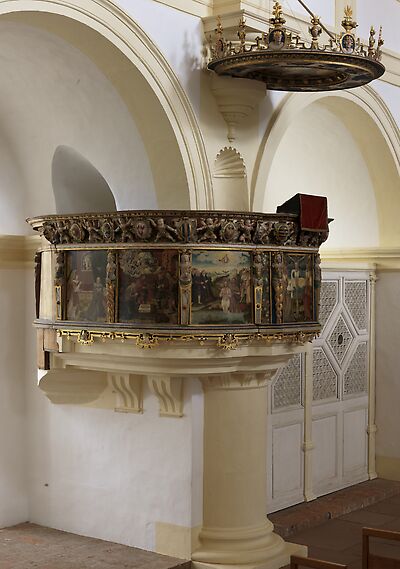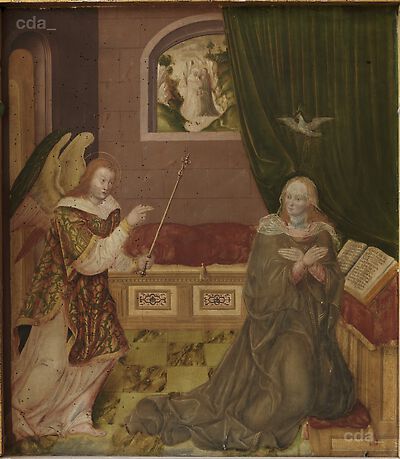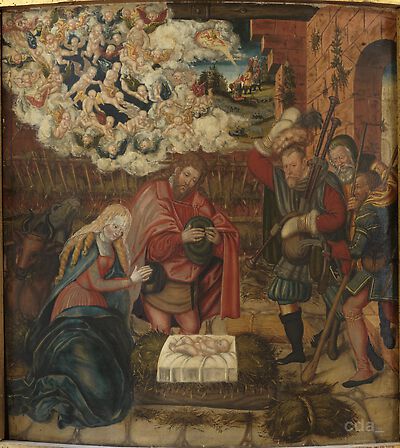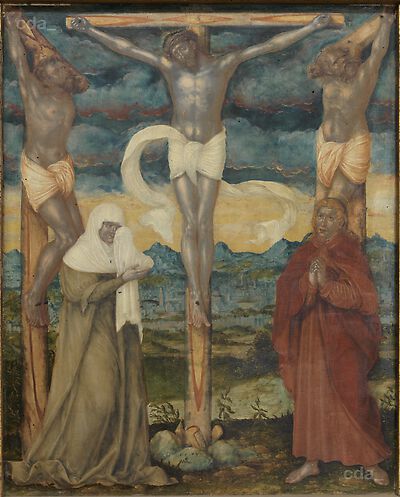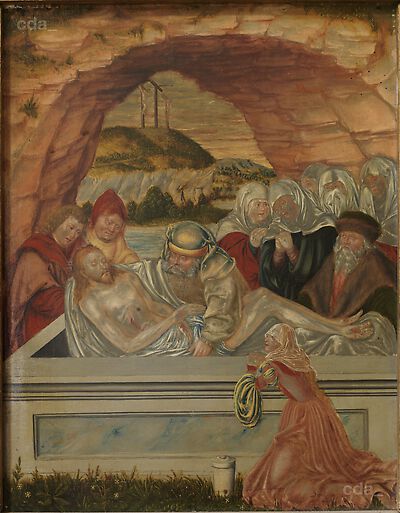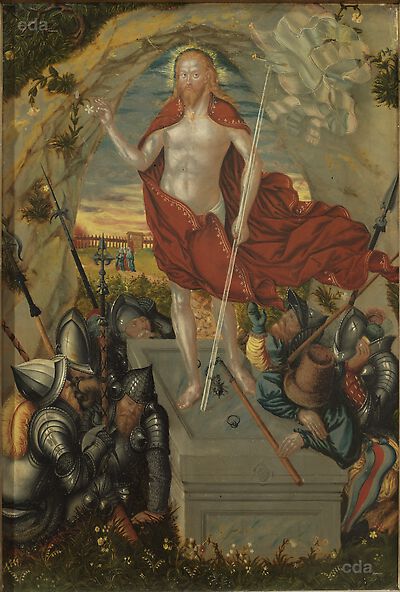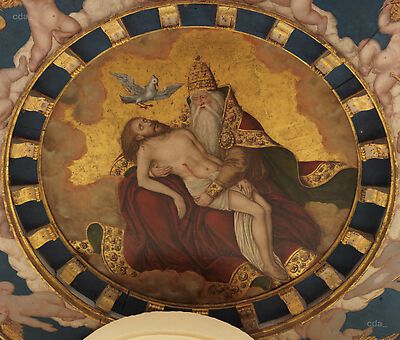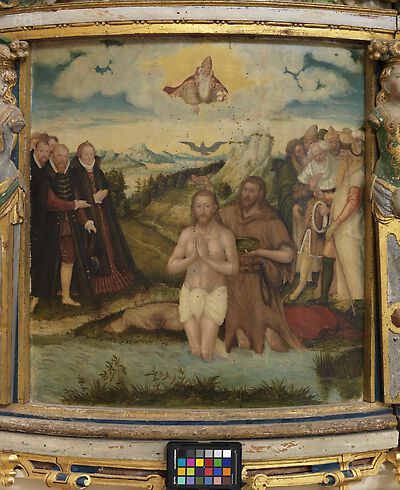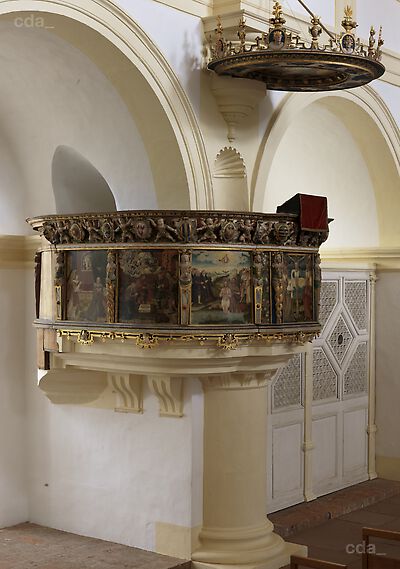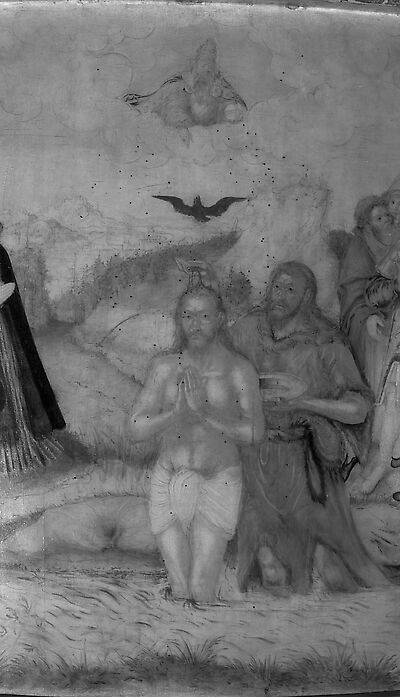Support
The panels are mounted in the pulpit and due to the coniferous wood paneling are not accessible from the reverse, therefore any assessment of the support remains conditional. In the few areas where bare wood is visible it is pale in appearance.
The examination report from 1990 of the conservation of the abat-voix states that its panel painting was executed on lime wood. The support of the altarpiece created by Cranach the Younger for the castle chapel was also lime wood. It may therefore be assumed that the pulpit paintings were also painted on lime wood.
When viewed in raking light one join is visible, suggesting that the panel consists of two planks.
[Herrschaft 2013, 35, 37]
Ground and Imprimatura
A thin glue-chalk ground was applied with a brush to the sized support. On the right and left edges of the panel the ground extends to the edge of the support. Similar to the Nativity scene the Bapism panel exhibits a small lip at the top edge 2.6 cm in width where the panel may have been fixed while the ground was applied. There is a thin lead white imprimatura covering the ground.
[Herrschaft 2013, 39]
Underdrawing
The underdrawing on the pulpit paintings was executed on the imprimatura. The lines were carried out in a dry drawing material, possibly a grey/black chalk. The sketchy underdrawing is executed with delicate lines. The arcs and wiggly and zig-zag forms bear witness to a lively, almost nervous drawing technique. The underdrawing is only partially binding. This applies mainly to the contours, which were often repeatedly drawn (e.g. Christ's left elbow). On the other hand the economic indication of inner forms are less binding, as shown by the arrangement of the folds in most of the garments. In the background the town and the castles are only vaguely indicated, likewise trees were only indicated with a few curved lines. Numerous formal clarifications were carried out during the painting process. To a limited exent this applies to the garments and the background already mentioned above. The position of St John the Baptist's leg is completely different from the underdrawing. The correction did not occur in the underdrawing but rather during the painting process. In the group of figures on the right edge of the painting some lines from the underdrawing, which were not covered by paint, are visible to the naked eye. The artist forgot to execute the prophet Daniel's headdress in paint, leaving the underdrawing visible. On the man behind the prophets the paint layer ends on the underdrawing line of the hatrim. This gives the impression that the artist intentionally left the dark line visible as a contour.
It is hard to image that the painting was completed on the basis of this underdrawing and without reference to a pre-existing design or a prototype.
[Herrschaft 2013, 41, 43]
Paint Layers and Gilding
The paint layers probably consist of pigments bound in oil (a test for protein proved negative). On all the panels the paint layers extend to the edge at the sides - like the ground - whereas the paint layers at the top and bottom end before the ground.
By and large all the panels exhibit a very economic painting technique with a thin application of paint, which nevertheless is predominantly opaque. In addition there are areas of glazed colour, where the imprimatura is occasionally visible and influences the colour scheme of the panel.
The quality of the painting is very mixed and reveals the cooperation of more than one person on each panel. Many of the affectionately executed details are only visible close up, which considering the position of the panels 2 meters above is never possible. Other areas are less precise and occasionally unfinished (this is also the case for the decorative painting on the pulpit).
Of the six pulpit paintings the Baptism is of the highest painterly quality. The figures of Jesus, St John, God the Father and the electoral pair are very delicate and executed with great attention to detail, likewise the faces of both prophets on the right edge.
The electoral pair is dressed in floor-length gowns, which were initially painted in grey. The folds were modelled in a lighter grey and a floral ornamentation was then added in delicate black lines to create the effect of velvet. St John's fur robe was created by painting the folds in flesh coloured brushstrokes over a greyish brown ground. Fur is only painted along the hem with pale and dark brushstrokes. This suggests that St John wears his robe with the leather side turned outwards.
The faces of Jesus and St John were painted very softly with barely any brushstrokes visible. There are no contour lines. Volume was created by the soft transitions from the brown paint in the shadows to light grey mid-tones and flesh tones for the light areas and highlights. The latter was occasionally applied more thickly and some brushstrokes are visible. The eyes of both are brown with white points of light or - dashes. Black was only employed for the pupils and a short stroke for the eyelids, which is confined to above the pupil. Delicate strokes were employed to paint the hairs of St John's eyebrows and eyelashes, but not for Jesus. The execution of the bodies observes the same principles employed in the faces. In addition to the brown paint used to describe forms and for the shadow, grey paint was applied for the midtones and a flesh tone for the lighter areas. For this purpose the paint was no longer applied in discrete glazed layers, but rather juxtaposed with blurred transitions, so that the imprimatura could augment the luminosity of the flesh paint in the light areas. The faces of the electoral pair and prophets are executed in the same way.
The headdress of the prophet Daniel has a fur-trimming. The imitation of fur was achieved by employing short brown brushstrokes. The ground is visible on rest of the headdress as no further paint appplication occurred. The man between the two prophets wears a hat with a broad, upturned rim finished with a red glaze with yellow highlights.
[Herrschaft 2013, 52 – 55]

